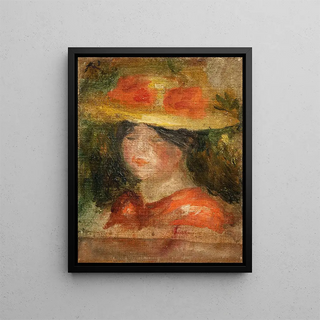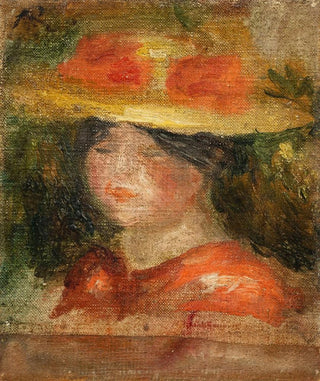Art print | Woman's head in hat - Pierre-Auguste Renoir


View from behind

Frame (optional)
Pierre-Auguste Renoir’s iconic art print, "Head of a Woman in a Hat," embodies the very essence of feminine beauty and delicacy. Painted during the heart of the Impressionist movement, this canvas captivates the viewer and inspires admiration through its subtle portrayal of an elegant woman, whose adorned hat evokes a certain refinement. Renoir, master of colors and lights, manages to capture not only the features of his model but also the atmosphere of an era where fashion and society intertwine harmoniously. This piece, a true ode to femininity, takes us on a visual journey where every detail seems to tell a story.
Style and uniqueness of the art print
Renoir’s style is distinguished by his ability to seize the present moment while infusing a timeless dimension into his subjects. In "Head of a Woman in a Hat," the technique of quick, vibrant brushstrokes allows for a lively rendering of textures, fabrics, and lights. The nuances of colors, ranging from warm tones to softer shades, blend with remarkable fluidity, creating an atmosphere that is both intimate and luminous. Renoir’s art lies in his way of expressing emotions through harmonious compositions, where each element contributes to the overall beauty. The woman’s posture, her slightly averted gaze, and the delicacy of her hat’s details reflect a unique artistic sensitivity, making this art print unforgettable.
The artist and his influence
Pierre-Auguste Renoir, an emblematic figure of Impressionism, left a lasting mark on his era with his bold and innovative artistic vision. Born in 1841, he evolved within a vibrant artistic milieu, mingling with other great masters such as Monet and Degas. His focus on light and color revolutionized painting, influencing generations of artists worldwide. Renoir did not merely paint portraits; he immortalized moments of life, emotions, and atmospheres. His work, rich in humanity, demonstrates a deep respect for his models, often women, whom he depicts with tenderness.

Matte finish

View from behind

Frame (optional)
Pierre-Auguste Renoir’s iconic art print, "Head of a Woman in a Hat," embodies the very essence of feminine beauty and delicacy. Painted during the heart of the Impressionist movement, this canvas captivates the viewer and inspires admiration through its subtle portrayal of an elegant woman, whose adorned hat evokes a certain refinement. Renoir, master of colors and lights, manages to capture not only the features of his model but also the atmosphere of an era where fashion and society intertwine harmoniously. This piece, a true ode to femininity, takes us on a visual journey where every detail seems to tell a story.
Style and uniqueness of the art print
Renoir’s style is distinguished by his ability to seize the present moment while infusing a timeless dimension into his subjects. In "Head of a Woman in a Hat," the technique of quick, vibrant brushstrokes allows for a lively rendering of textures, fabrics, and lights. The nuances of colors, ranging from warm tones to softer shades, blend with remarkable fluidity, creating an atmosphere that is both intimate and luminous. Renoir’s art lies in his way of expressing emotions through harmonious compositions, where each element contributes to the overall beauty. The woman’s posture, her slightly averted gaze, and the delicacy of her hat’s details reflect a unique artistic sensitivity, making this art print unforgettable.
The artist and his influence
Pierre-Auguste Renoir, an emblematic figure of Impressionism, left a lasting mark on his era with his bold and innovative artistic vision. Born in 1841, he evolved within a vibrant artistic milieu, mingling with other great masters such as Monet and Degas. His focus on light and color revolutionized painting, influencing generations of artists worldwide. Renoir did not merely paint portraits; he immortalized moments of life, emotions, and atmospheres. His work, rich in humanity, demonstrates a deep respect for his models, often women, whom he depicts with tenderness.






